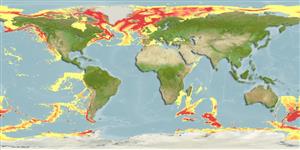Polychaeta |
Aciculata |
Nephtyidae
Environment: milieu / climate zone / ระดับความลึก / distribution range
นิเวศวิทยา
; ระดับความลึก 21 - 4200 m (อ้างอิง 119523). Polar
Indo-Pacific, Northern Atlantic, Arctic and the Mediterranean Sea: Western Europe.
Length at first maturity / ขนาด / Weight / Age
วัยเจริญพันธุ์: Lm ? range ? - ? cm Max length : 10.0 cm TL เพศผู้/กระเทย; (อ้างอิง 75621)
Maximum depth from Ref. 116516.
Life cycle and mating behavior
วัยเจริญพันธุ์ | การสืบพันธุ์ | การวางไข่ | Eggs | ความดกของไข่ | Larvae
Members of the class Polychaeta are mostly gonochoric (sexual). Mating: Females produce a pheromone attracting and signalling the males to shed sperm which in turn stimulates females to shed eggs, this behavior is known as swarming. Gametes are spawned through the metanephridia or body wall rupturing (termed as "epitoky", wherein a pelagic, reproductive individual, "epitoke", is formed from a benthic, nonreproductive individual, "atoke"). After fertilization, most eggs become planktonic; although some are retained in the worm tubes or burrowed in jelly masses attached to the tubes (egg brooders). Life Cycle: Eggs develop into trocophore larva, which later metamorph into juvenile stage (body lengthened), and later develop into adults.
Cusson, M., P. Archambault and A. Aitken 2007 Biodiversity of benthic assemblages on the Arctic continental shelf: historical data form Canada. Mar. Ecol. Prog. Ser. 331:291-304. (อ้างอิง 3448)
IUCN Red List Status
(อ้างอิง 130435: Version 2025-1)
CITES status (อ้างอิง 108899)
Not Evaluated
CMS (อ้างอิง 116361)
Not Evaluated
Threat to humans
Human uses
| FishSource |
เครื่องมือ
ข้อมูลเพิ่มเติม
นิเวศวิทยาเขตร้อนFood items (preys)องค์ประอบของอาหารการบริโภคอาหารผู้ล่า Population dynamicsการเจริญเติบโตMax. ages / sizesLength-weight rel.Length-length rel.Length-frequenciesMass conversionอุดมสมบรูณ์ Life cycleการสืบพันธุ์วัยเจริญพันธุ์ความดกของไข่การวางไข่EggsEgg developmentLarvae Human RelatedStamps, coins, misc.
แหล่งที่มาจากอินเตอร์เน็ต
Estimates based on models
Preferred temperature
(Ref.
115969): 0.1 - 7.7, mean 1.2 (based on 555 cells).
Fishing Vulnerability
Low vulnerability (10 of 100).
Price category
Unknown.
